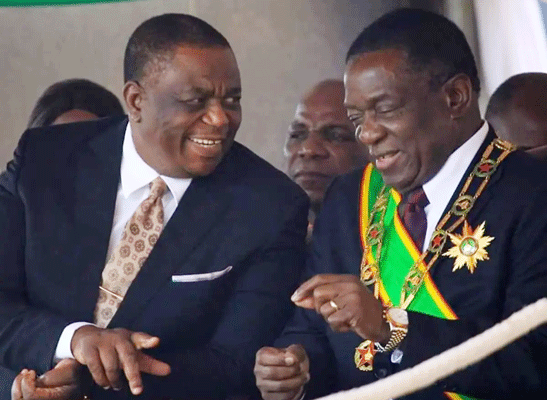Mnangagwa’s route to 3rd term not so easy, despite 2 thirds
Common Law with Mike Murenzvi
“Learn and obey the rules very well so you will know how to break them properly.” ~ Dalai Lama XIV
“You can’t do that, Scout. Sometimes it’s better to bend the law a little in special cases. In your case, the law remains rigid. So to school you must go.” ~ Atticus Finch (To Kill a Mockingbird)
“2030! VaMnangagwa vanenge vachipo!” (2030! President Emmerson Mnangagwa will still be in office!) This is the ZANU-PF slogan that has begun making the rounds at party meetings and more so at the recent Robert Gabriel Mugabe National Youth Day commemorations in Masvingo on 21 February 2024.
They would have to jump through a maze of legal hoops to achieve this. Here, we examine the steps that would need to happen to make this a reality. Any reference to a “section” speaks to the Constitution of Zimbabwe.
Term limits and the Constitution
Section 95 declares that the term of office of the President runs for five years. Coupled with this, Section 91 states that a person is disqualified from election as President if he or she has already held the office for two terms, whether continuous or not.
It further states that a term is a minimum service of three years in the case where the incumbent ascended to the office at some point due to circumstances other than a general election.
President Mnangagwa is six months into his second term. By all accounts, including his own words, this is his final term in office.
“I am going for my second term. It is my last term,” Mnangagwa told ZTN in a pre-election interview on Monday 21 August 2023.
In 2018, he told CNN: “The maximum is two terms, for any president, and I will abide by that.”
Constitutional Amendments
According to Section 328, to effectively extend presidential term limits, there must be two separate Constitutional Bills passed by each house of Parliament and voted for by a public majority in a referendum.
Subsection (7) of Section 328 states: “Notwithstanding any other provision of this section, an amendment to a term-limit provision, the effect of which is to extend the length of time that a person may hold or occupy any public office, does not apply in relation to any person who held or occupied that office, or an equivalent office, at any time before the amendment.”
What this means is that the incumbent or any other person who has held the office can’t benefit from any constitutional amendment that extends the term limits.
So, by this standard, Mnangagwa can’t enjoy the benefits of any changes to term limits. But that’s not the end of it. As with anything in the Constitution, this clause can be amended.
Section 328(8) says that the change in the voting structure and methods of Constitutional Bills, as well as the limitations placed on beneficial extension of term limits, cannot be amended in the same Bill.
What does all this mean? It means that Mnangagwa would first need a Bill to remove the law that says he cannot benefit from term limit extensions.
This would need him to face a referendum. He would also need a second Bill to change the term limits themselves.
Before a Constitutional Bill goes to Parliament, it must be gazetted for 90 days. This is to allow for public debate.
After this, the Bill is presented in the National Assembly. Parliament must then convene public meetings nationwide to gather public views on the proposed amendments.
As with other normal Bills, a report on the public’s views must be presented as part of the debate surrounding the Bill. The Bill will then be tabled before Parliament.
Parliament Composition and Voting
Our Parliament consists of 280 members of the National Assembly and 80 Members of the Senate. When voting on a Constitutional Bill, it must pass with positive votes of at least two-thirds of the entire membership of each house. This translates to 187 in the National Assembly, and 54 in the Senate.
The current composition of the houses is as follows:
House ZANU-PF CCC Senator Chiefs PWD Reps Required Votes
National Assembly 190 90 187
Senate 33 27 18 2 54
On paper, in the National Assembly, ZANU-PF has enough votes to carry the motion, but in the Senate, it is short by at least one vote.
This is assuming that all the Senator Chiefs and representatives of Persons with Disabilities vote for the motion.
The numbers above are on the assumption that all ZANU-PF members support the proposed amendments and that all CCC MPs are against it. Whether there are any dissenting votes on either side of the aisle remains to be seen.
Previous Voting Record of Constitutional Amendments
Of the two Constitutional amendments so far, Amendment No.2 had the greatest challenge to its passing in both houses. There was a misinterpretation of how the two-thirds was calculated.
There were also discrepancies on how many, and who voted yes on the day of the vote, as names are recorded. Lastly, there were extensive delays in initiating voting because of several deaths of ZANU-PF members and failure to marshal all required members to the house on certain days.
In summary, this is what Mnangagwa’s supporters would need to do to clear his path to an extra term: convince MPs to amend the Constitution two times, hold public consultations on the proposed changes, and face a referendum.
As can be seen, amending the Constitution will not be as easy as those ZANU-PF supporters calling for it may imagine.
This is especially so for a hot topic such as term limits. The will of the people must reign supreme.
Mike Murenzvi writes in his personal capacity and his views are not associated with any organisation he is, or may be, affiliated with.



